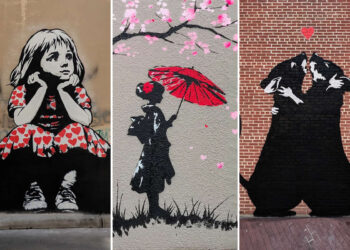Throughout history, art has served as more than just decoration; it’s a medium through which artists communicate complex ideas, hidden messages, and profound emotions. Many of the world’s most famous paintings contain concealed meanings, historical references, and mysteries that continue to captivate and puzzle audiences. Here, we explore 10 iconic paintings that reveal intriguing hidden meanings and secrets.
1. The Last Supper by Leonardo da Vinci
![]()
Leonardo da Vinci’s The Last Supper is renowned for its exquisite depiction of Jesus and his disciples during their final meal. Beyond its beauty, da Vinci embedded clues and symbols that have sparked intense debate. Scholars have noted that the positioning of the apostles and Jesus forms a series of mathematical relationships, including a symbolic use of the number three, reflecting the Holy Trinity. Additionally, some believe that Mary Magdalene is portrayed beside Jesus, a detail that fuels theories around her role in Jesus’ life.
2. The Creation of Adam by Michelangelo
![]()
Michelangelo’s masterpiece on the ceiling of the Sistine Chapel, The Creation of Adam, is celebrated for its lifelike portrayal of God imparting life to Adam. However, upon closer inspection, God and the angels form a shape strikingly similar to a human brain, which some interpret as Michelangelo’s suggestion that intellect and divinity are interconnected. This theory is supported by Michelangelo’s knowledge of anatomy, which he studied intensely, and raises questions about his thoughts on human consciousness and the divine.
3. Mona Lisa by Leonardo da Vinci
![]()
The Mona Lisa is undoubtedly one of the most famous paintings in history, but it also remains one of the most mysterious. The subject’s enigmatic smile has baffled viewers for centuries, as it seems to shift based on the viewer’s perspective. Researchers have analyzed her facial features, proposing that da Vinci may have used a combination of techniques to create an optical illusion, allowing her expression to change. Furthermore, some believe the background landscape holds symbols and messages relating to da Vinci’s own life and philosophies.
4. The Ambassadors by Hans Holbein the Younger
![]()
Hans Holbein’s The Ambassadors appears to be a straightforward portrait of two men, but it includes a peculiar detail—a distorted skull at the bottom. When viewed from a specific angle, the skull becomes clear, serving as a memento mori, or reminder of mortality. The objects surrounding the men, such as scientific instruments and books, symbolize the fleeting nature of worldly knowledge and possessions, suggesting a deeper commentary on life’s impermanence.
5. The Garden of Earthly Delights by Hieronymus Bosch
![]()
This triptych by Hieronymus Bosch is both visually captivating and perplexing, with scenes that represent heaven, earth, and hell. The central panel, The Garden of Earthly Delights, is filled with bizarre and symbolic imagery that some interpret as warnings about the consequences of earthly pleasures. Bosch’s vivid depictions of indulgence and chaos offer a glimpse into medieval concerns about sin, while hidden musical notes and obscure symbols continue to spark debate about the artist’s true intentions.
6. The Persistence of Memory by Salvador Dalí
![]()
Salvador Dalí’s The Persistence of Memory, famous for its melting clocks, has fascinated viewers with its dreamlike, surreal quality. Often interpreted as a representation of time’s fluidity, the painting reflects Dalí’s fascination with memory and the unconscious. Hidden within the landscape is an abstract self-portrait of Dalí, seen in the central “face” with a drooping nose and eye. The clocks may represent the surrealist idea of time slipping away in dreams, or even the distortion of memory itself.
7. Guernica by Pablo Picasso
![]()
Pablo Picasso’s Guernica is a powerful anti-war statement that illustrates the horrors of the Spanish Civil War. This chaotic black-and-white scene depicts suffering and devastation, yet it holds many cryptic symbols. The bull and the horse, often present in Spanish culture, are seen here with ambiguous meanings, representing innocence and brutality. The broken sword, lightbulb (symbolizing the sun or technology), and the fragmented bodies contribute to Picasso’s haunting condemnation of violence and its impact on humanity.
8. The Night Watch by Rembrandt
![]()
Rembrandt’s The Night Watch is famed for its dynamic composition and dramatic use of light and shadow. Yet, beyond the initial impact, the painting includes subtle details hinting at the personalities and statuses of each figure. For instance, a small girl in a golden dress holds a chicken, symbolizing the kloveniers (Dutch musketeers) and possibly representing the guild’s wealth. This layering of symbols within the bustling scene gives a deeper insight into Amsterdam’s civic pride and the social hierarchy of Rembrandt’s time.
9. American Gothic by Grant Wood
![]()
Grant Wood’s American Gothic has become an emblem of rural America, but the painting may be less straightforward than it seems. The stern expressions and rigid poses of the farmer and his daughter (or possibly wife) are thought to symbolize both resilience and the struggles of the Great Depression. Some art historians believe that Wood intended to blend admiration and satire in his portrayal, questioning the traditional American values associated with the rural Midwest.
10. The Birth of Venus by Sandro Botticelli
![]()
Botticelli’s The Birth of Venus is a celebration of beauty, but its deeper layers of meaning reflect Renaissance ideals of love and divinity. Venus, depicted as the goddess of love, represents both physical and spiritual beauty, a theme that resonated with Neoplatonic philosophy of the time. Furthermore, scholars suggest that the shell she stands on symbolizes femininity and the womb, elevating Venus not only as a symbol of love but also as one of creation and rebirth.
Conclusion
These iconic paintings continue to captivate audiences, not only for their aesthetic beauty but also for the intricate stories they conceal. The hidden meanings embedded within these works remind us that art is a reflection of the human experience—layered, complex, and often mysterious. By uncovering these secrets, we gain a deeper appreciation for the artists’ intent and the timeless messages they’ve left behind.










